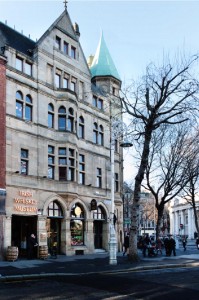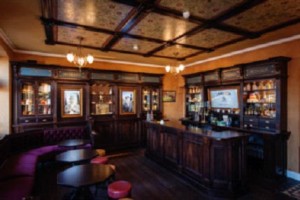Irish Whiskey Museum
Published in Issue 5 (September/October 2015), Reviews, Volume 23
Above: The entrance is located between two shops and may be easy to miss.
The Irish Whiskey Museum is Dublin’s latest, and it has a prime site opposite the front gate of Trinity College. The entrance is located between two shops and may be easy to miss, which may account for the fact that there were only four other people on the tour that I took, although the 3pm tour, we were told, was fully booked out.
You can only visit the museum as part of a tour, so we had a guide to lead us through the various rooms. This is a commercial operation, so there is a fee to get in, with a standard tour, a VIP tour and various concessions. The main exhibits are in four themed rooms; while each is heavy on reconstructions and videos, there are authentic artefacts from Ireland’s whiskey heritage on display as well.
The tour begins in the monks’ room, where our guide explained the origins of the word whiskey and its history. The history, illustrated by a video, goes backwards from Irish whiskey’s golden age in the nineteenth century to the arrival of the Normans. This might be slightly confusing for some visitors from overseas, but not to worry, since general history is there mainly to provide a backdrop to the story of Irish whiskey. If I were being strict, I would have to say that I disagreed with some of the interpretations of Irish history provided and was left wondering why people in the tourist industry pander to negative stereotypes of the Irish (from barbaric chieftains to sleekit poteen-makers).
The next room was described as a shebeen and we were told how the dissolution of the monasteries by Henry VIII led to the domestication of distilling, while later taxes resulted in the illicit production of poteen. The room itself was barn-like, with a simple still along one wall and a coffin serving as a table. In describing the origins of the modern Irish whiskey industry, our guide touched along the way on the Irish language, storytelling, wakes, traditional music and so on.
The final room is done up like a Victorian pub, and clever use of videos brings Ireland’s great distillers, from George Roe to John Locke, to life in an entertaining and informative way. From a historical point of view, we were on firmer ground here in dealing with the eighteenth and nineteenth centuries and the development of the whiskey industry. Of course, alongside the historical narrative we also had the technicalities of producing whiskey, the ingredients and different varieties explained—including why Irish is superior to Scotch. In an anteroom to the tasting room, a time-line made up of historic whiskey bottles follows the development of Irish whiskey in the twentieth and twenty-first centuries, explaining the impact of the world wars, Independence, Prohibition and so on. This concludes with the growth of the smaller craft distilleries in recent years.
Finally, we are led into the tasting room and handed over to a barman for the sampling of Irish whiskey itself. Those on the standard tour get to sample three whiskeys; those on the VIP tour get an extra whiskey and a certificate making them an ‘ambassador for Irish whiskey’. It must be said that both the guide and the barman were excellent. Each judged the level of interest and knowledge of the group (two Americans and two Malaysians besides myself) and comfortably engaged with them, imparting knowledge, sharing a joke and expressing their own opinions on the different kinds of Irish whiskey. The samples of whiskey were generous and I was glad that I was taking the bus home afterwards!
When I thought of going to this museum, the €15 for a standard tour struck me as being a bit dear, but on leaving the building I thought it was money well spent. I like to think I know a lot about whiskey but I did learn some new things. The museum is directed at tourists and it strikes the right note between information and entertainment. Everyone left with some knowledge of Irish history and a good idea of the history of Irish whiskey (including the now largely forgotten 1906 court case brought by the Irish distillers against the Scotch). The mix of people, reconstructions, whiskey memorabilia and videos works really well in bringing you through the museum, keeping your interest alive and still being informative.
This museum does not claim to be anything it is not; while an Irish visitor may not get much from it, tourists will certainly enjoy it and come away with an appreciation of Irish whiskey. It compares fa

Left: One room is described as a shebeen and includes a poteen still.
vourably with Dublin’s other whiskey attraction, the Jameson Old Distillery, and with the Scotch Whisky Heritage Centre in Edinburgh. The latter has more razzmatazz (you travel through it in a whisky barrel) but less substance than the Irish Whiskey Museum.
So if you have an hour to spare in Dublin and want something different from the usual museum, go here. For a visitor from overseas, this is an ideal place to visit, with its mixture of information, charming blarney (in the nicest sense) and samples of genuine Irish whiskey.
Tony Canavan is editor of Books Ireland.
















